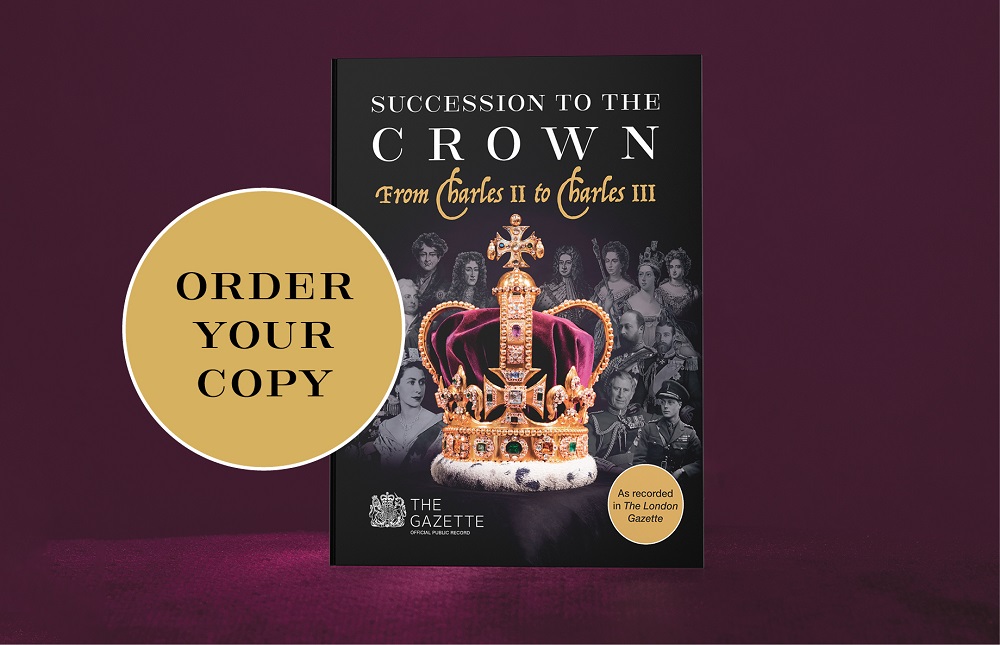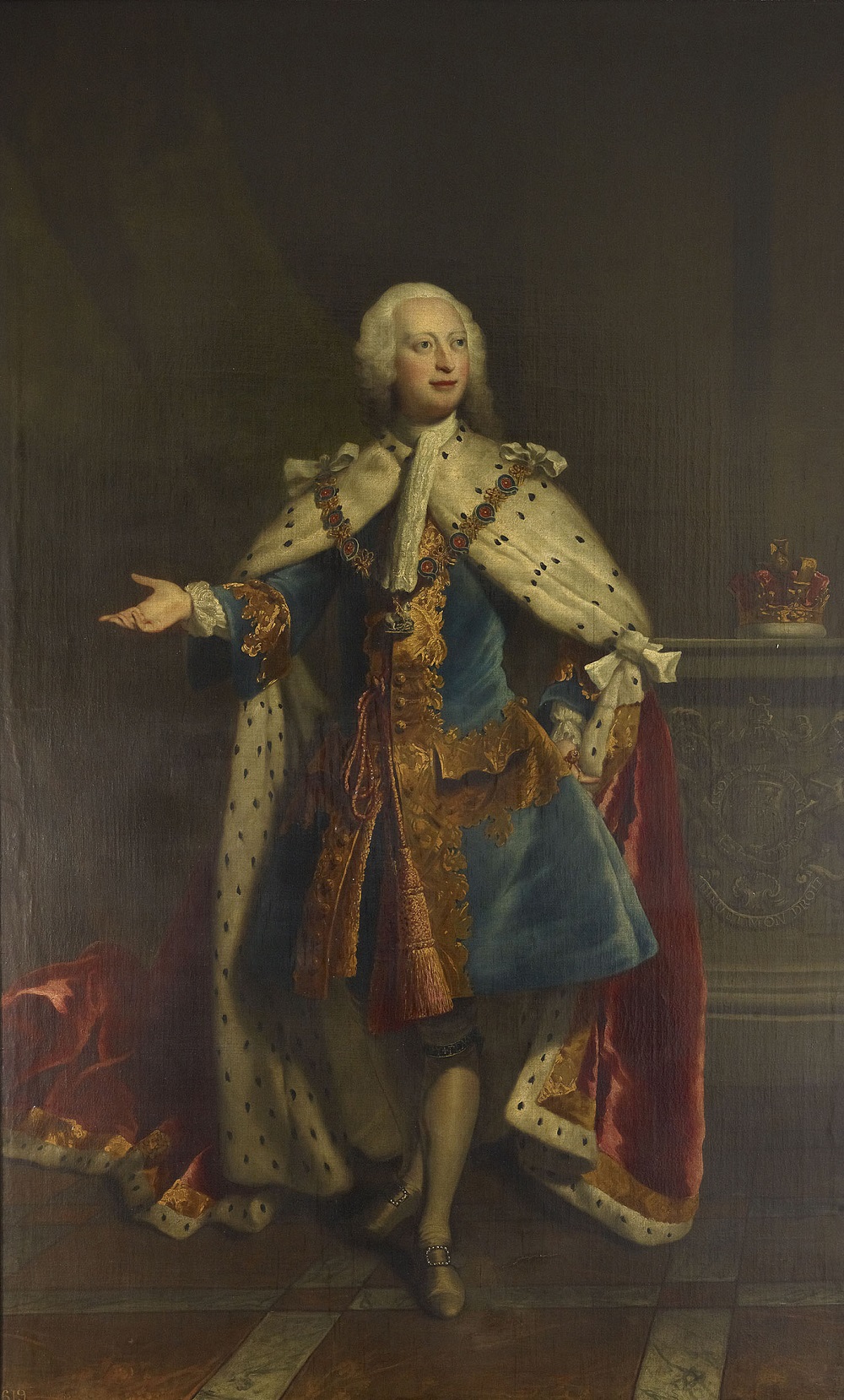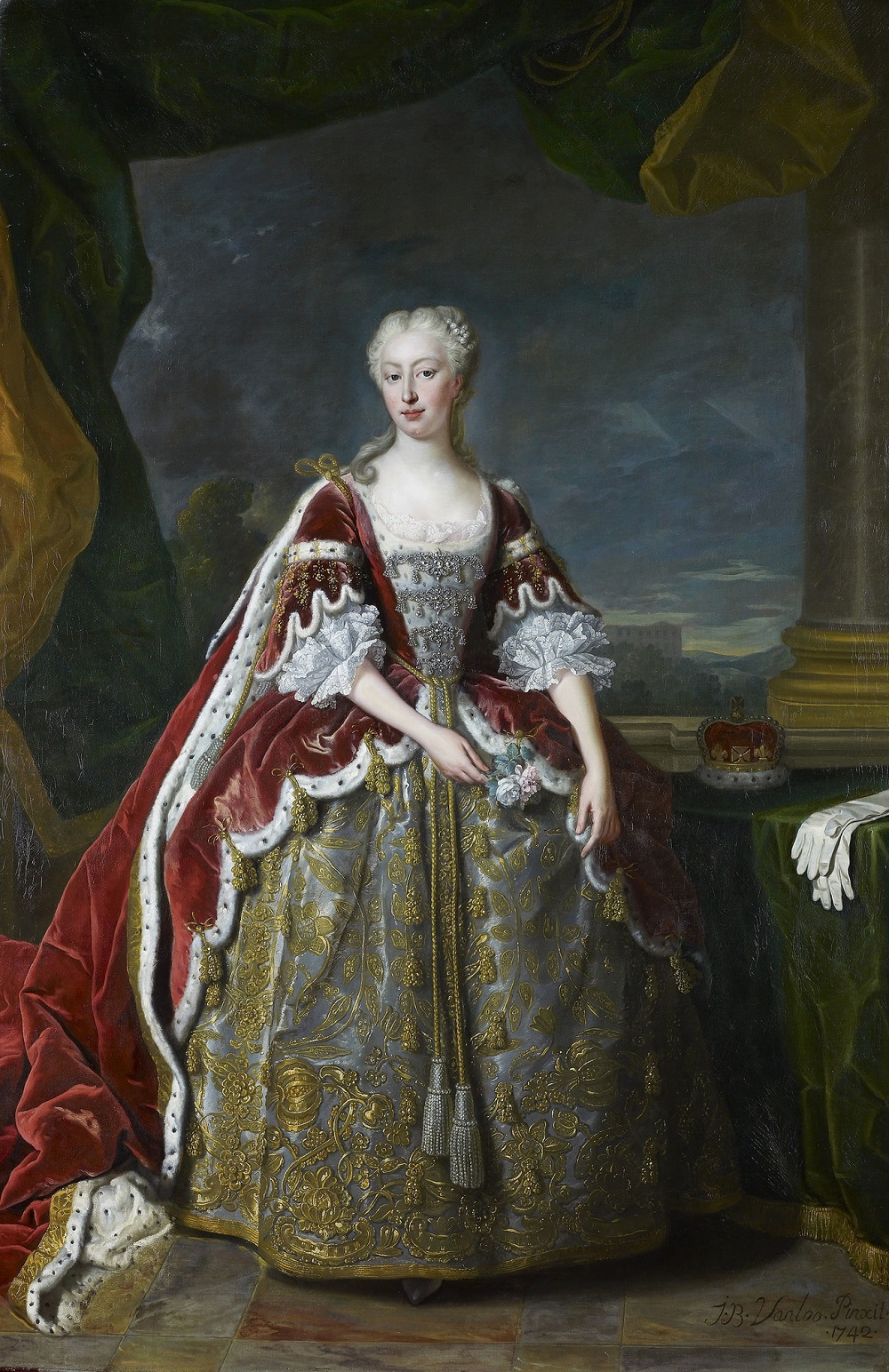Succession to the Crown: King George II

As the official public record since 1665, The Gazette has been recording successions to the Crown for over three centuries. As part of our ‘Succession to the Crown’ series, historian Russell Malloch looks through the archives at the accession and reign of King George II, as described in The Gazette.
Chapters
Succession to the Crown paperback

To celebrate the new king’s coronation, The Gazette’s Succession to the Crown series has been released in paperback.
Available to order now from the TSO Shop, the Succession to the Crown paperback explores the coronations, honours and emblems of the British monarchy, and includes an exclusive chapter on the accession of King Charles III.
Find out more in the link below.

Accession
The London Gazette reported the death of King George I as he made his way to Hanover in the summer of 1727 (Gazette issue 6590), but there was no difficulty with the formal transfer of the royal authority as his heir – George Augustus, Prince of Wales – was in London when the messenger arrived with the news from Osnabrück, in contrast to the situation in 1714 when the late king was in Hanover when he learned that he had succeeded Queen Anne.
King George II’s accession council was held at Leicester House in London, and on the following morning his style and titles were announced at the usual locations in the city. The accession proclamation adapted the text from 1685, but omitted any reference to the Princess of Wales, now Queen Caroline, who would exercise the royal powers on a number of occasions. The individuals who signed the proclamation included the Duke of Queensberry, who had approved the act that led to the union of the kingdoms in 1707, as well as Sir Robert Walpole, a former lord justice and founder knight of the Bath (Gazette issue 6590).
The King took the oath relating to the security of the Church of Scotland, and the ordinary business of exercising the royal authority continued as usual. The same Gazette that dealt with the Scottish oath reported a knighthood being conferred on one of London’s aldermen, Robert Baylis, after the corporation delivered a speech to congratulate the King on coming to the throne.
Foreign relations
The 1727 accession declaration was the first to mention the international reach of the Crown, as the King said he was taking on the government of a nation “so powerful at home, and of such influence and consequence abroad,” and he promised to cultivate alliances to preserve the balance of Europe.
The Gazette had already reported the appointment of several men to act as the Crown’s representative at locations that lay well beyond the British Isles, as with the nomination of governors for places such as Barbados and Jamaica in the Caribbean, and Maryland, New York and Nova Scotia in North America. The accession process did not involve any reference to the separate powers or honours that were associated with these foreign possessions, and no addition was made to the royal titles to reflect any of the Crown’s overseas interests until the title of empress of India was given to Queen Victoria in 1876.

Queen as Regent
The King followed his father’s example and regularly returned to Hanover, which had the added attraction of being the home of his mistress, Sophia von Wallmoden, who became the countess of Yarmouth in April 1740 (Gazette issue 7898).
His first European trip was organised in 1729, and The Gazette recorded a few British honours being conferred while he was overseas, as well as the occasion at Lüneburg when the King knighted John Emmerson, the deputy governor of the Merchant Adventurers of England residing in Hamburg when they presented an address to welcome George to his German dominions (Gazette issue 6804).
A different system of administering the government was introduced, as The Gazette explained that in May 1729 assent was given to “An act to enable Her Majesty to be regent of this kingdom during His Majesty’s absence, without taking the oaths” (Gazette issue 6778). The act allowed Queen Caroline to be regent “either by the style of guardian of the realm of Great Britain, and His Majesty’s lieutenant within the same” or by “any other style or title whatsoever”, and provision was made to remove the requirement to take oaths or make declarations before being able to exercise the royal authority.
The 1729 act did not limit the Queen’s powers, but in practice she followed the justices and took no independent action as regards to the award of honours during her husband’s absence. There was also little that needed to be done, as the British honours system was of such a limited extent at this period, and the King’s ministers were content to leave vacancies in the orders to remain unfilled for the time being.
Three officials were nominated to assist the Queen, including the speaker of the House of Commons, and more than 30 privy counsellors met at Kensington Palace on 22 May 1729 when the Queen’s commission was read. The Gazette reported almost nothing of her work before the King returned in September, beyond the appointment of a clerk for the Privy Council, an audience with the secretary of the French embassy to convey news about the birth of a son to King Louis XV, and a council to prorogue Parliament.
The Gazette’s limited coverage of the royal activities in England contrasted with its reporting of what was happening in Hanover, as there were extensive accounts about the King’s involvement in public events, including troop reviews and a visit to a mint where he saw crown pieces being struck (Gazette issue 6799).

Return to Hanover
Similar steps were taken to manage the government in London during the King’s later visits to Hanover in 1732 and 1735, and a couple of Gazettes mentioned the Queen’s activities as regent, as when she authorised the appointment of a herald (Gazette issue 7416), and directed letters patent to grant an Irish peerage to William Duff, a member of the Westminster Parliament (Gazette issue 7412).
The Queen acted as regent for the last time shortly after the court learned about the marriage of her son, the Prince of Wales, to Princess Augusta of Saxe Gotha in April 1736 (Gazette issue 7502).
In his speech to Parliament less than a month after the wedding, the King found no role for his son in managing the affairs of state, but instead continued to rely on his wife while he was away. The King said “The experience you have already had of her just and prudent administration, will, I doubt not, engage you all to make the weight of the publick affairs as easy to her, as her wise conduct will render the government agreeable to you; and this I recommend to you in a particular manner” (Gazette issue 7508).
The Privy Council gathered again in May 1736 when Queen Caroline’s commission was read for the last time (Gazette issue 7510). The Gazette continued to favour news from Hanover over London, although the Queen’s name did appear in proclamations that prohibited assistance being given to Corsicans in their dispute with the Republic of Genoa, and for punishing the individuals who caused an explosion in Westminster Hall. She also gave an audience to the envoy from Lisbon after the death of a member of the Portuguese royal family, and received letters of credence from the resident from the Republic of Venice.
No award of any honours were made under the delegated authority during 1736, although the Queen did direct patents to be issued for matters that ranged from the appointment of an Irish dean, to the professor of civil law at Oxford, and “the office of master bricklayer of all His Majesty’s works, buildings, and reparations in England” (Gazette issue 7541).
Queen Caroline died in November 1737 (Gazette issue 7651), after having played an active role in public life on several occasions when her husband went to Europe, but no steps were taken to appoint a regent for the remainder of the reign, which lasted until the death of the King in the autumn of 1760.

After Caroline
King George II maintained a poor relationship with his son, the Prince of Wales, who was the most obvious person to replace his mother as regent. The depth of the family’s division was illustrated by the notice in The Gazette of February 1738 in which the lord chamberlain reminded readers “that no persons whatsoever, who shall go to pay their court to their Royal Highnesses the Prince and Princess of Wales, shall be admitted into His Majesty’s presence, at any of his royal palaces” (Gazette issue 7679).
The King left England several times after his wife’s death, and the old system of lords justices was revived in May 1740, and employed several times after that. The justices of 1740 were typical of the high officials from the past, ranging from the archbishop of Canterbury to Sir Robert Walpole, who was now the first commissioner of the Treasury and prime minister.
The award of honours was suspended while the King was away, although the business of the orders continued to operate under the direction of royal deputies, with thirteen Garter or Bath installations being performed in that way between 1727 and 1760. The Gazette’s reporting of the ceremonial life of the orders was variable during that period, and often preferred news about the activities of European knights, over what was happening with the knights in England.

Dettingen
The justices were in place when the King witnessed notable events in the War of the Austrian Succession (1740-48), as he was present at the battle of Dettingen in Bavaria, an action that resulted in the Order of the Bath being used to reward military services, which set a precedent that can be found in an easily recognisable form in the Gazettes of the 21st century.
The Gazette reported the part played at Dettingen by General Philip Honywood and Lieutenant-Generals Campbell, Cope and Ligonier, as well as their nomination as knights of the Bath on 12 July 1743 (Gazette issue 8239), and their investiture by the King “in the presence of all the nobility, general officers, and other persons of distinction” (Gazette issue 8248).
The King was also absent two years later when news arrived about further engagements in the War of the Austrian Succession, including the outcome of the battle of Fontenoy near Tournai in May 1745, and the capture of Cape Breton in North America in June of that year.
Of even greater relevance to the security of the Crown, he was away when reports arrived from France that King James’s grandson Charles had embarked “in order to land in some part of His Majesty’s kingdom”. This was the start of the second major rising in support of the Jacobite cause, which led the justices to issue a proclamation in August 1745 that offered £30,000 to any person who seized and secured the Young Pretender.
The King declared “his intention to speedily return to England,” (Gazette issue 8456) and the Gazette later reported the final confrontation of the opposing forces on the battlefield at Culloden near Inverness, as well as some of the honours that were given to the King’s brother William, Duke of Cumberland, for his work against the Stewarts, including an act that settled an additional revenue of £25,000 on the duke and his heirs “for the signal services done by His Royal Highness to his country” (Gazette issue 8542).
Cumberland’s name had already featured in The Gazette, as when he became a founder knight of the Bath, a knight of the Garter and a privy counsellor. What was more important was that he was also in line to succeed to the Crown, next after the Prince of Wales and his sons, and this close connection with the throne became a political issue when the Prince of Wales died in March 1751 (Gazette issue 9042), leaving no children who were over 18 years old.

After Frederick
In May 1751 assent was given to “An act to provide for the administration of the government, in case the Crown should descend to any of the children of his late Royal Highness Frederick Prince of Wales, being under the age of 18 years, and for the care and guardianship of their persons.” The government preferred to trust the King’s daughter-in-law with the care of the royal inheritance rather than the Duke of Cumberland, and the act gave the Dowager Princess of Wales “full power and authority [...] to exercise and administer, according to the laws and constitution thereof, the regal power and government of this realm” and to “execute all prerogatives, authorities, acts of government and administration of government, which belong to the king or queen of this realm to do and execute, according to law”.
The act contemplated a council being appointed to assist the princess, which consisted of the Duke of Cumberland, the archbishop of Canterbury and several other public figures. The council had an explicit role as regards the award honours, as the regent was unable to create any peerages without the consent of a majority of her council. No such consent was imposed on her ability to grant any other form of royal favour.
The 1751 scheme was never required, as the King remained in control of the royal authority for the rest of his life, and so Princess Augusta never needed to assume the regency, or to act with the consent of any council before her eldest son (the future King George III) reached the age of 18 years in 1756.
Absent again
Two more sets of justices were nominated between the passing of the regency act and the end of the reign. The King’s penultimate trip to Hanover lasted for more than seven months, and began shortly after he attended a Garter chapter in March 1752 at which the Prince of Wales and the Duke of Cumberland helped him to present the insignia to Prince Edward (later Duke of York), and the Prince of Orange was declared to be a knight (Gazette issue 9148).
A few days after the Garter ceremony the King gave his assent to several acts of Parliament, including one that amended an earlier provision “for regulating the commencement of the year, and for correcting the calendar now in use” (Gazette issue 9152), a measure that would affect the date on which honours were conferred, as England and Ireland moved from the Julian to the Gregorian calendar, and started numbering years on 1 January rather than Lady Day (25 March).
A Garter installation was performed by commission at Windsor in June, and the Prince of Orange was invested with his Blue Riband at The Hague by the British envoy to the States General, even although the King was on the Continent at the time. The King was also overseas when the Gregorian calendar was introduced in England, which led to the loss of 11 days in September 1752 and resulted in an issue of the Gazette that ran from Tuesday 1 September (Old Style) to Saturday 16 September (New Style) (Gazette issue 9198).

Lords Justices
The last justices of the reign were nominated in April 1755, and included the Duke of Cumberland (Gazette issue 9471), who was the first member of the royal family to be given that role. The introduction of the King’s brother to the administration had no practical effect in terms of the grant of honours during a visit that would last for only four months.
The Gazette recorded little of what the King did during his final trip, which would be the last overseas visit by a British monarch until 1821. In early July there was, however, an unusual account from Hanover about judicial business in Scotland, involving an appointment for Alexander Boswell, the father of the well-known biographer of Samuel Johnson (Gazette issue 9493).
The King left Hanover and reached Margate on 16 September 1755 and Kensington Palace later that same day (Gazette issue 9511). Three days later he received a customary address from the lord mayor, aldermen and commons of the City of London, and then conferred the honour of knighthood on the recorder and two of the city’s sheriffs (Gazette issue 9512).
The King remained in England for the rest of his life, and so no steps were required to delegate the royal authority for that reason after 1755. He also continued to appoint commissioners to supervise Garter installations, and so the Dukes of Kingston and Marlborough were nominated in March 1757 and installed in St George’s Chapel in May 1760 (Gazette issue 9998).
There were no major, and few minor, changes to the scope of the honours system during King George II’s reign, which ended with his death on 25 October 1760 (Gazette issue 10046).
About the author
Russell Malloch is a member of the Orders and Medals Research Society and an authority on British honours.
Let us know what you think of this article by getting in touch. All feedback is welcome.
See also
Gazette Firsts: The history of The Gazette and royal coronations
The Demise of Queen Elizabeth II and Accession of King Charles III
Queen Elizabeth II - In Memoriam
Images (in order of appearance)
The Gazette
Royal Collection Trust / © His Majesty King Charles III 2022
Royal Collection Trust / © His Majesty King Charles III 2022
Noonans of Mayfair
Royal Collection Trust / © His Majesty King Charles III 2022
Getty Images
Royal Collection Trust / © His Majesty King Charles III 2022
Royal Collection Trust / © His Majesty King Charles III 2022
Publication date: 3 October 2022
Any opinion expressed in this article is that of the author and the author alone, and does not necessarily represent that of The Gazette.
